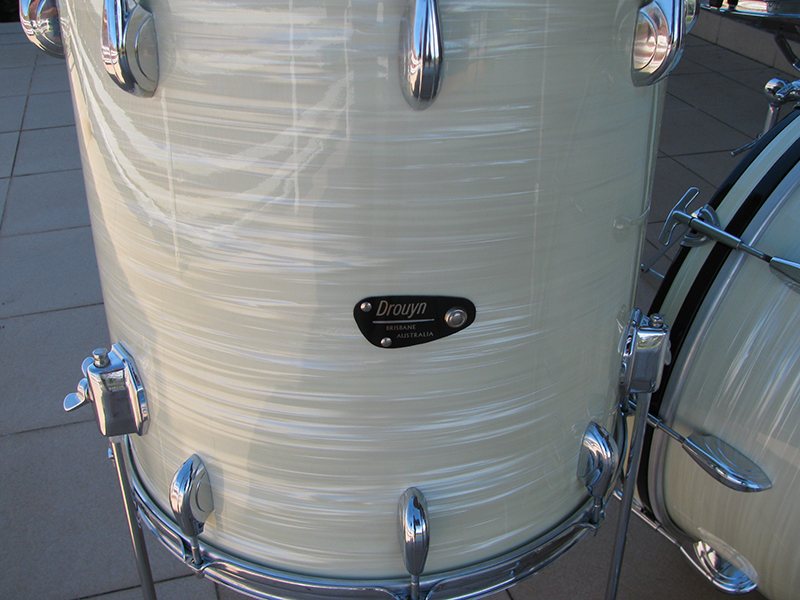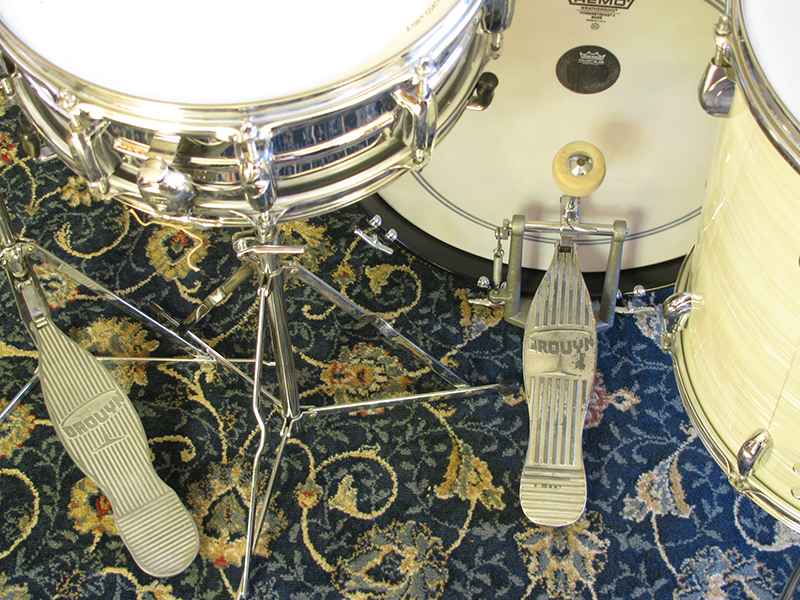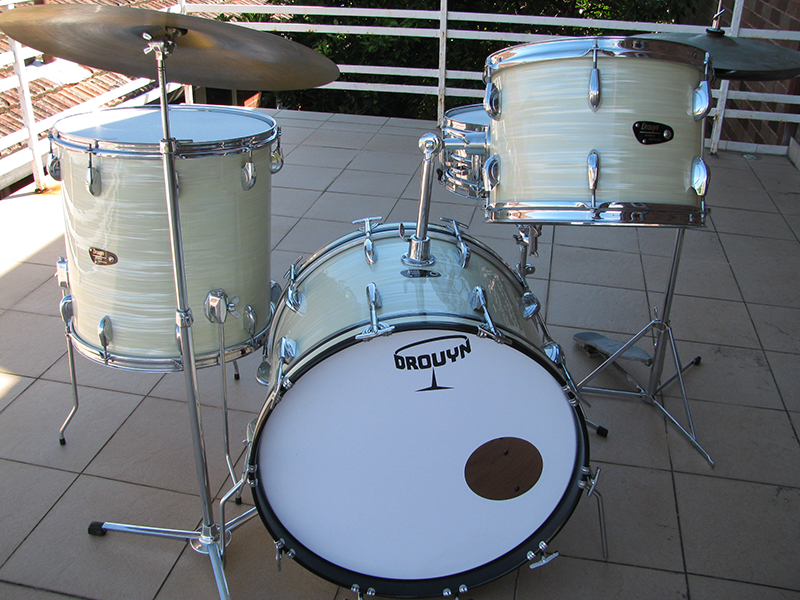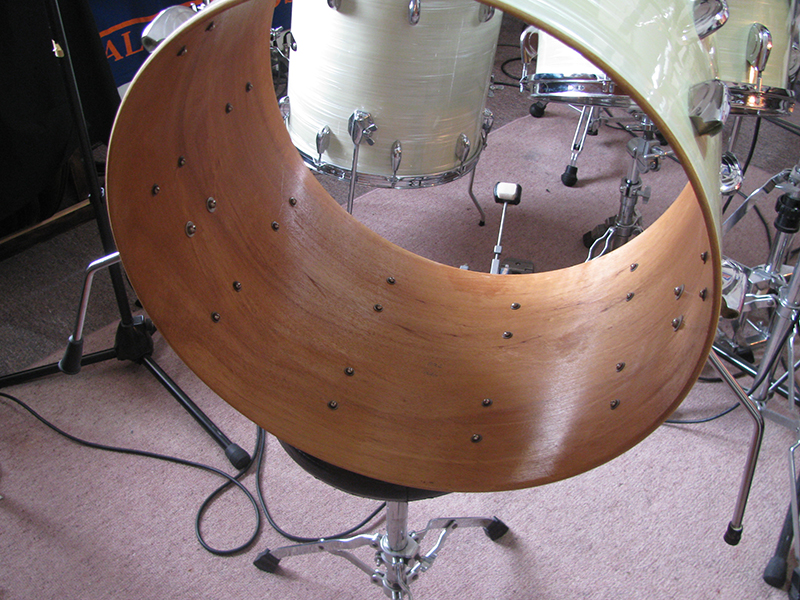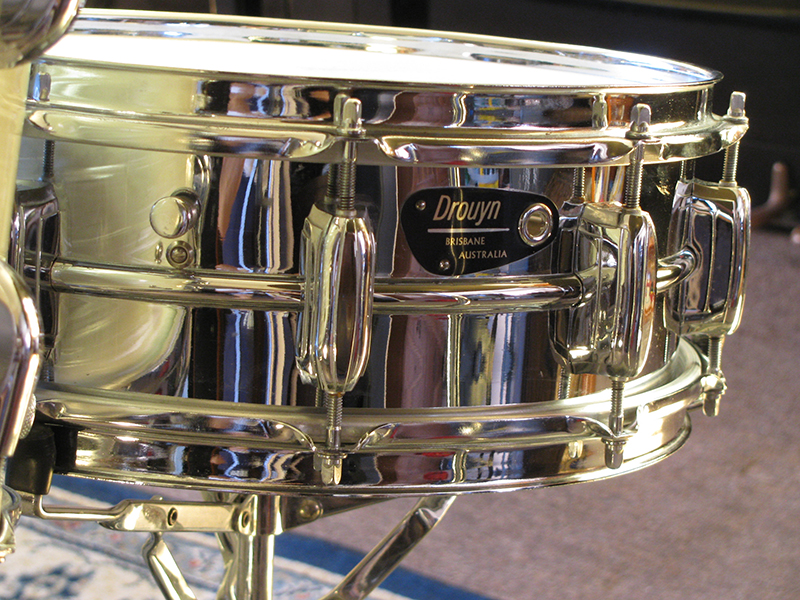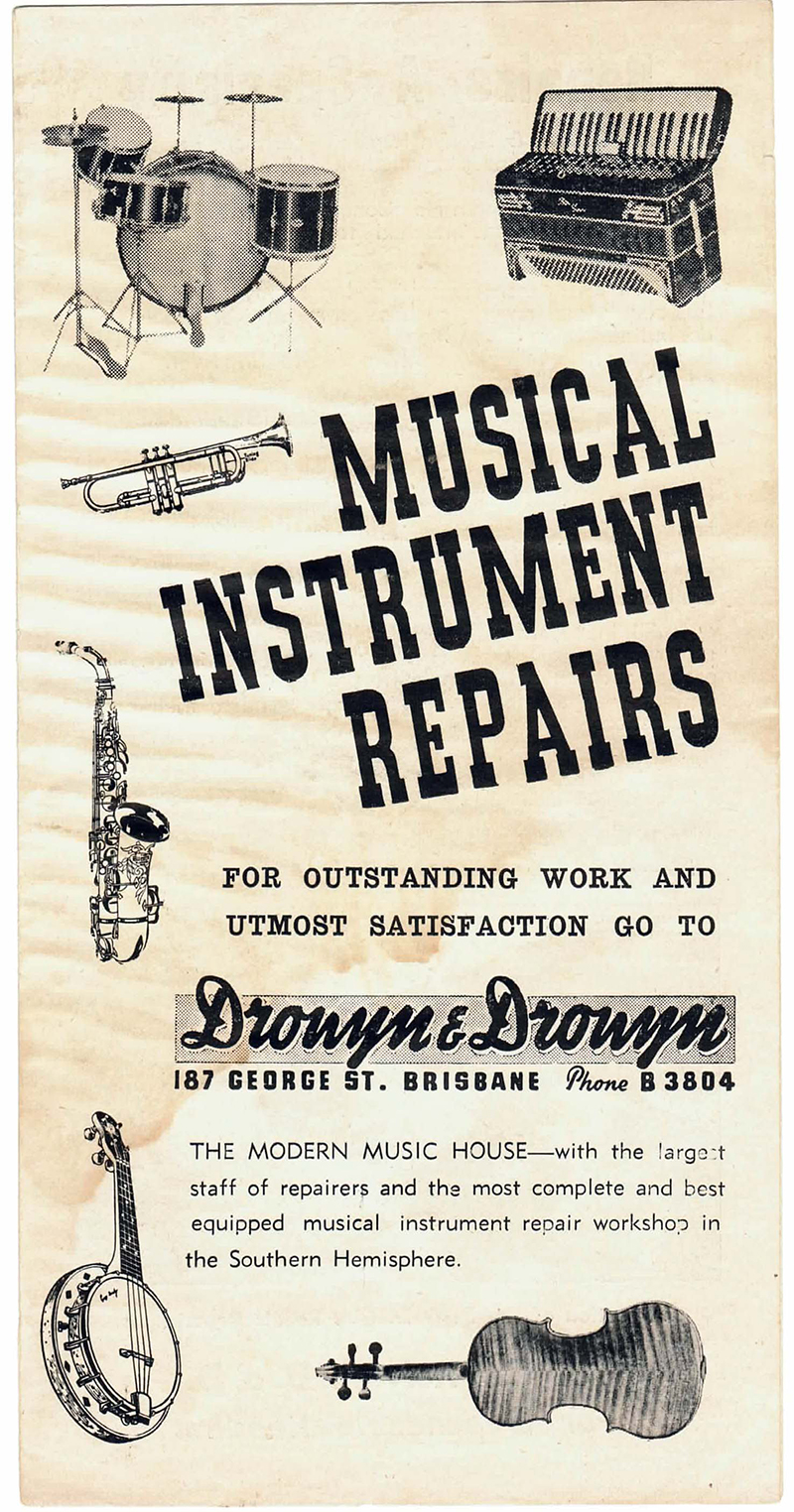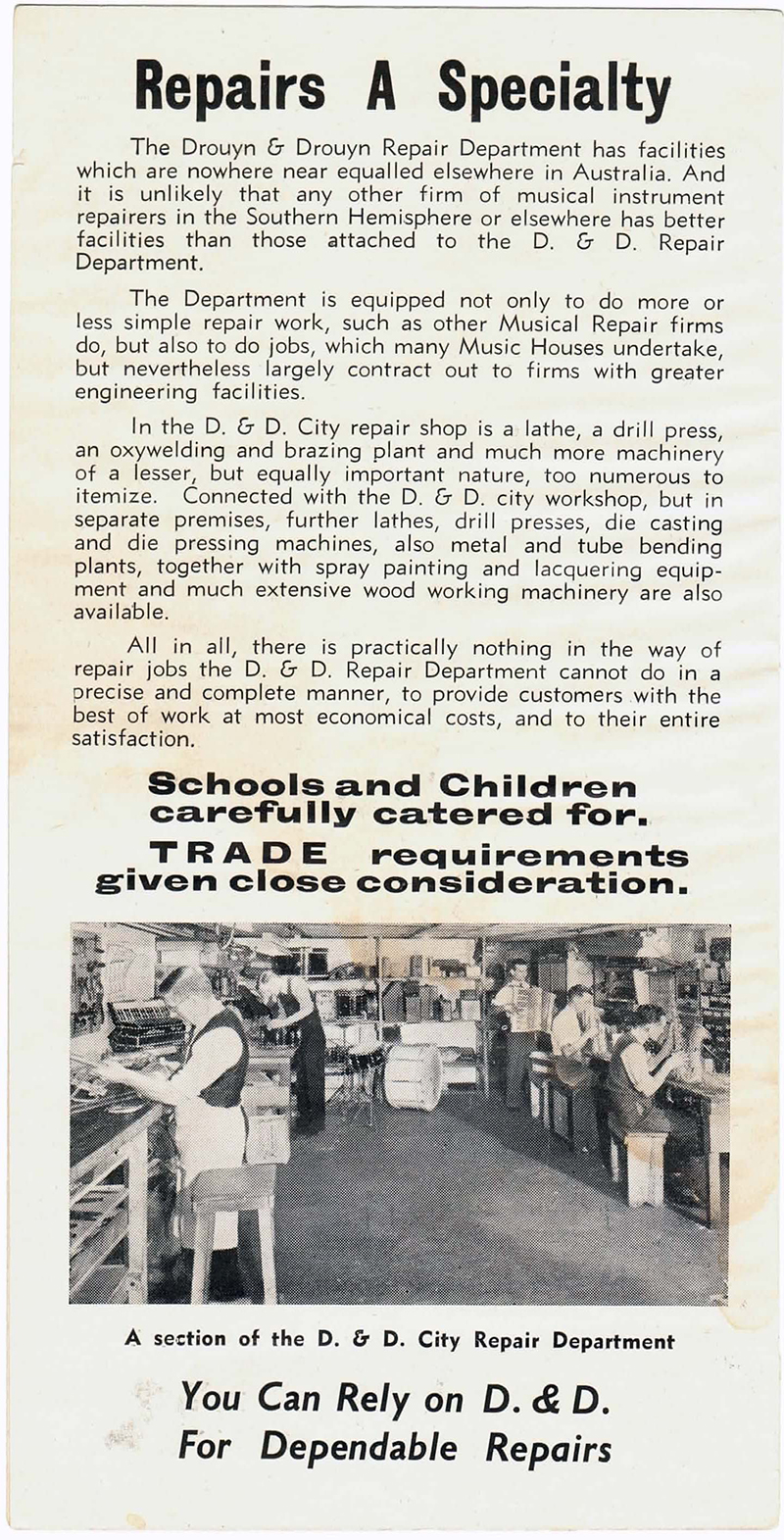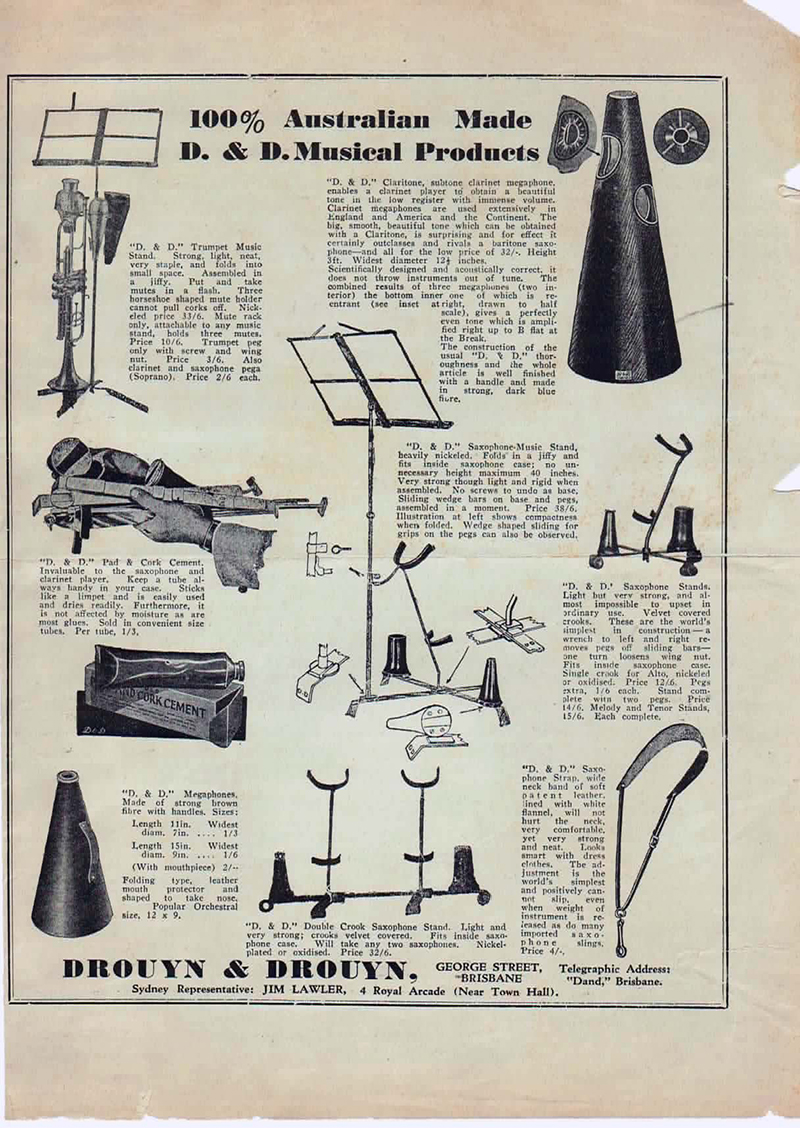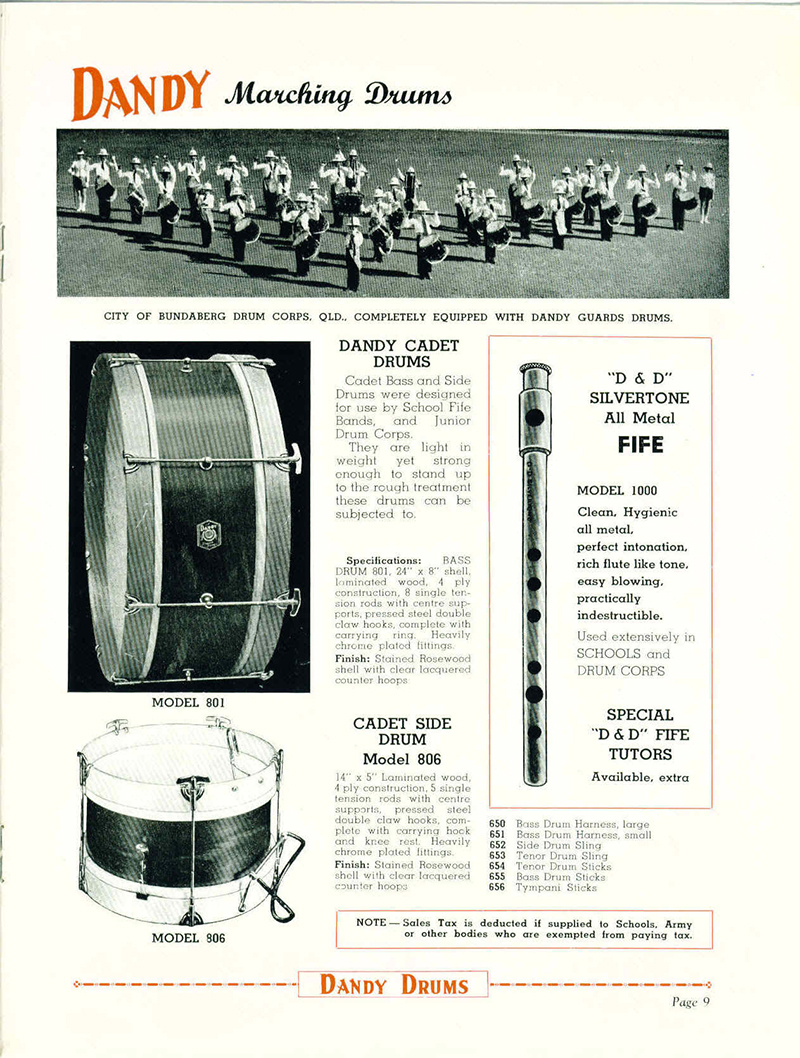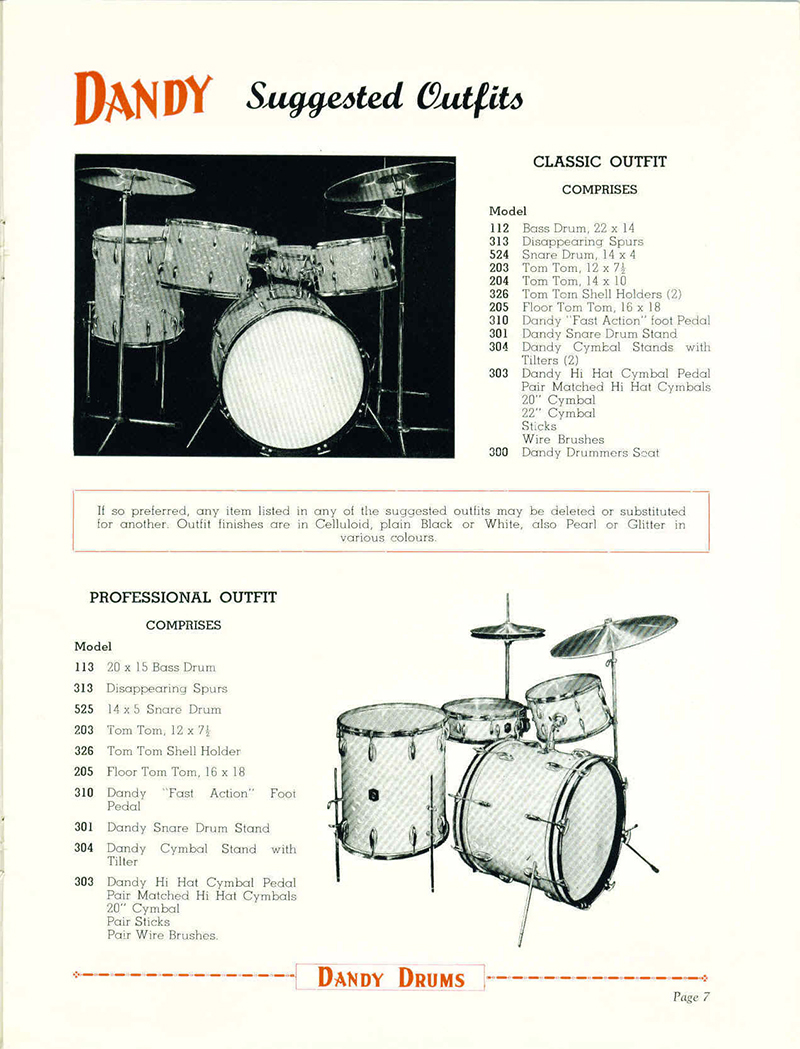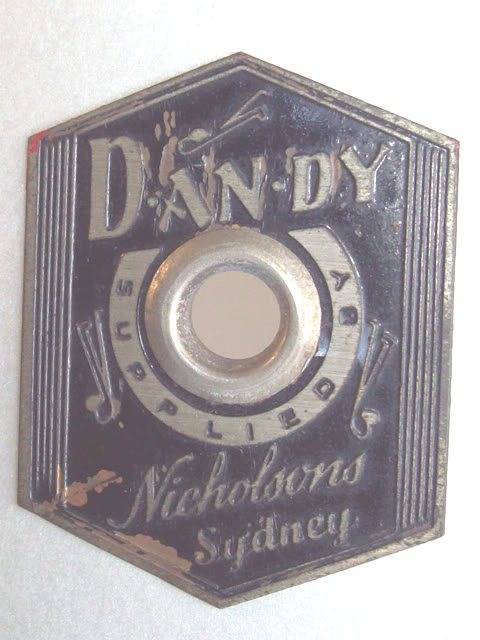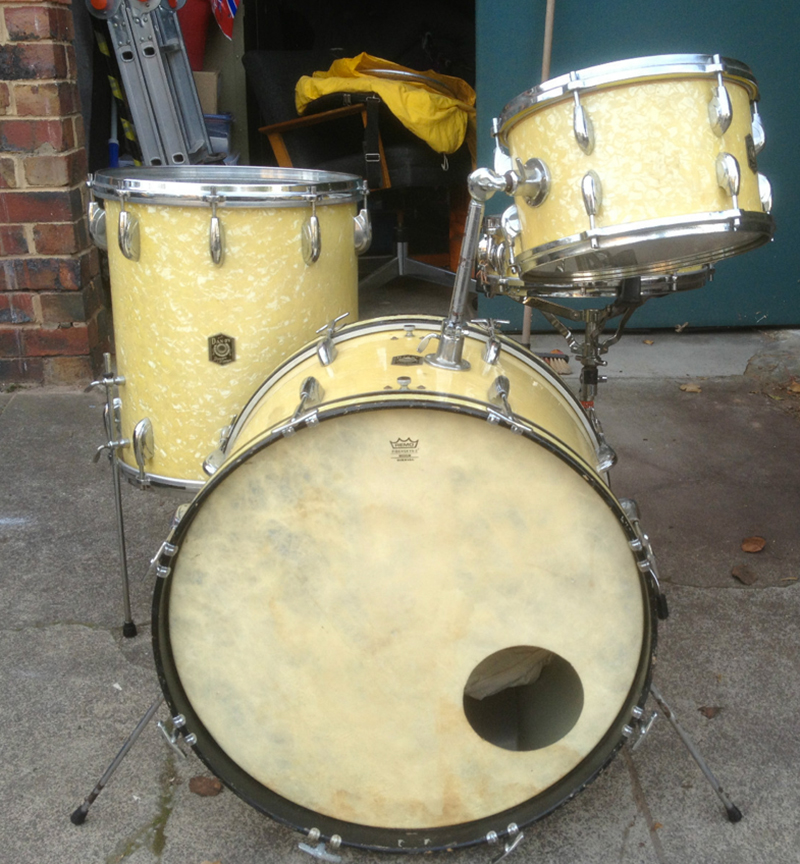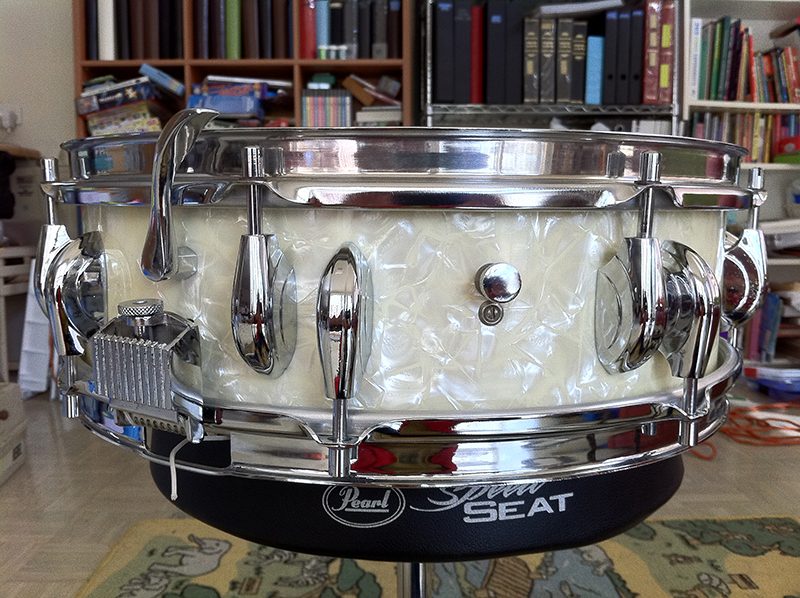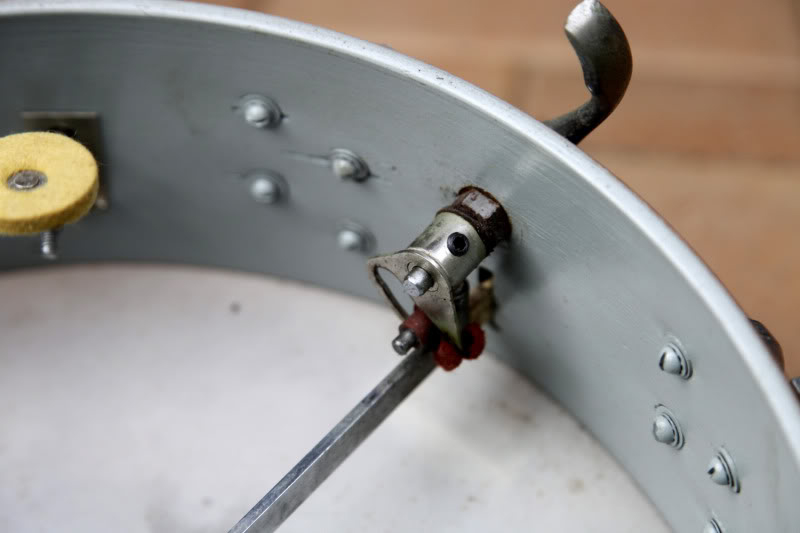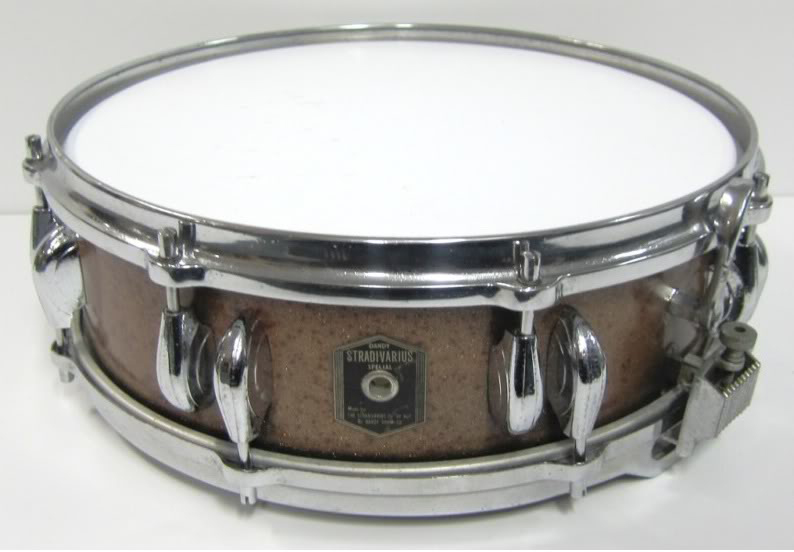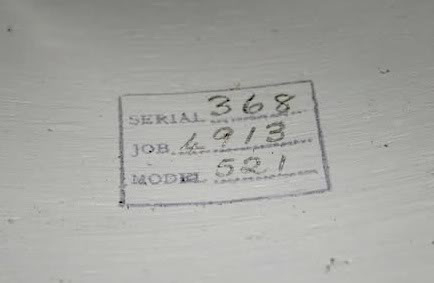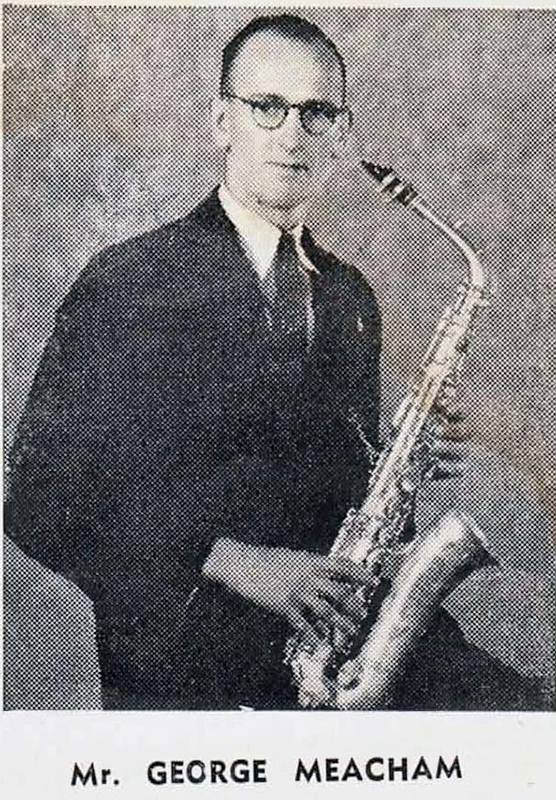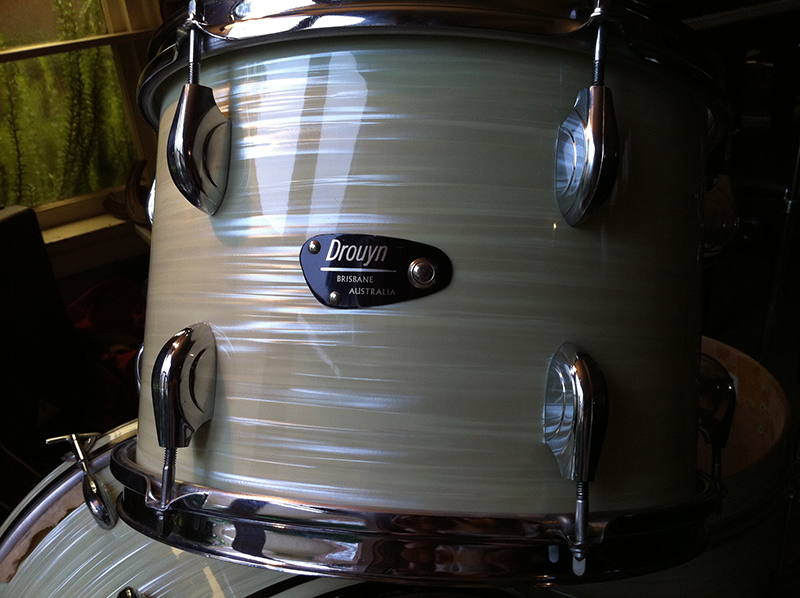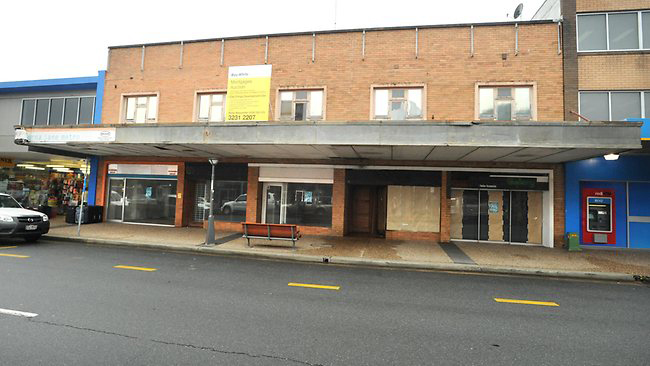Thunder from "Down Under" - The Drouyn StoryFeature Article by Paul Kneipp
This is a Drouyn “Professional Series” drum kit, circa 1965. The colour is most likely “Marine Mist Pearl”. The sizes are: 20/13/16, with a 14″ x 5″ S100 alloy snare. This drum kit was originally sold from Theo’s Music, St George’s Terrace, Perth, Australia in 1965 or possibly early 1966. It came with hardware, including the A602 foot pedal; the A600 hi-hat stand(or an earlier version of it) ; snare stand (model unknown) ‘Vynex’ vinyl cases in ‘Tobacco Tan’; 14″ Zildjian New Beat hi-hat cymbals (£28); 18″ Super Zyn medium cymbal; Premier cymbal stand and a small accessory case containing sticks, brushes, drum keys and a selection of drum books from the era.
The drums are 4 ply Rose Alder, an Australian native rainforest tree (now a protected species) with similar characteristics to maple. There are no re-enforcing rings. Drouyn also made shells from other native timbers such as Huon Pine and Jarrah, but details are sketchy, to say the least.
Complete kits in this condition are very rare, yet many were sold. It's hard to say why. Drouyn drums had issues with loss of chrome plating, perhaps due in part to the tropical climate in Queensland. This may have contributed to their disappearance.
The snare drum is the S100, a copy of the Ludwig LM400. They were so convincingly made that rumors of a collaboration with Ludwig have persisted ever since. Incredibly, these seamless shelled drums were made in the top floor of a small factory in Brisabane, Australia under the most humble of circumstances; and chromed by a local electroplater. The controversy and misinformation surrounding the S100 is typical of Drouyn. It seems that every second drummer has an opinion; a story; or a mate who worked there – but the truth remains as hard to find as complete examples of the drums. It would be fair to say that although Ludwig may have inspired the S100; they certainly did not make them.
My Drouyn Story
My Drouyn story begins with a kit I owned when I was about 14. I sold my first drum kit (an ancient Pearl) to a pawn shop and purchased the Drouyn set from the newspaper classifieds. This was in the 1970′s and the kit had a few different features from the one pictured, such as retractable spurs, a bass drum cymbal stand and slotted tension rods. I sold it a few years later for a red Premier B303 kit and in the years since, had always wished I had kept it.
I had been looking for a Drouyn kit for quite a while before I came across this one. It was an earlier model than my 70's kit, but looked to be in very good condition. My first impression after receiving it was that I had opened a time capsule from the 1960′s. Inside the bass drum were newspapers with stories about the disappearance of Australian Prime Minister Harold Holt. As I worked on the set, I began to understand some of the effort that had gone into it’s construction – and more than a few questions were raised as well. So began my journey into the fascinating world of Drouyn & Drouyn.
A Brief History of Drouyn & Drouyn
Long before Sleishman (who play their own role in this story); long before Brady, there were Australian drums being made in a small factory in the suburb of Stones Corner, Brisbane, Queensland. Brother and sister Douglas and Dorothy Drouyn (pronounced “drew-in”) shared a love of music. Douglas Drouyn was an accomplished musician. A search through the Australian National Library archive Trove finds many mentions of his gigs, including a tour through Queensland as far north as Cairns, in 1939. He played baritone saxophone in a duo with an accordionist, Ossie Mazzie. They were good enough to tour, act as leaders and pick up support bands; and were certainly popular. Dorothy Drouyn was also musical – it’s been reported that she wrote operettas. Douglas Drouyn also seems to have been a man with strong opinions about many things. He had a long running battle with the Tax Office over paying sales tax; eventually taking the fight to the High Court.
A judge in one episode of this trial noted that Douglas was not so much an activist, rather, “someone suffering from mental indigestion.” He certainly felt very strongly about it; and ruffled a few feathers, since he was subsequently investigated by the Government, for his alleged links to the monetary reformist Green Shirt movement. Whatever his political beliefs, the partnership with Dorothy flourished. Douglas and Dorothy became business partners in 1927. In 1932 they opened a music store in George Street, Brisbane specializing in instrument repairs.
Repairs a specialty!
This venture went so well that they purchased a small building in South Brisbane and began making drums and other small instruments under the “Dandy” brand name. The name was written as "D•and•dy and appears to have been an anagram of “D and Dy” (short for Douglas and Dorothy).
Dandy band catalogue – note the megaphone!
One thing is certain; they picked a good market. It’s been reliably estimated that they made over 20,000 fifes during the period the factory was most active. It seems that every school in Queensland owned a few instruments from the small factory in Stones Corner.
Dandy Serial Number System
Later they gave up the stamp and simply wrote these three rows of numbers in ballpoint pen inside the shells. It's a great pity that there is no sure way of knowing the exact system used. My personal theory is that the first 2 digits of the job lot are the year of manufacture. However, I've recently seen enough aberrations to accept that this can't be certified as fact; so I must honestly say that at this stage, I don't know and I don't think anyone knows for certain. My Drouyn kit was sold in 1965 or 1966. The job lot for all the drums begins with 65. I don't believe in coincidence, so I think my kit was made in 1965. I have seen many, many drums whose apparent age would support this "year/job lot" theory. But it'still just a theory.
The Meacham Factor - George Meacham
If there is anyone apart from Douglas and Dorothy Drouyn who was key to the success of the factory on Logan Road, it was an employee by the name of George Meacham. George was a trained machinist as well as a musician. He also appears to have been one of those people who could make virtually anything. George ran the factory for 44 years, designing and implementing much of the manufacturing. George’s input was vital, especially in two areas. Dandy/Drouyn drums had no internal reinforcing rings. Meacham designed a mold with an inflatable bladder which was used to hold the Drouyn ply drum shells perfectly round, while they set. If this is true, it would seem to be one of the first times in the world that this method was used.
Dandy Becomes Drouyn
Some time between 1960 and 1965, the Dandy brand was dropped for simply “Drouyn”, with a new badge and a new style. The drums changed, though not across all areas of the kit. The biggest change was the snare drum. In keeping with overseas trends, hoops with clips disappeared and new materials were used.
A Famous Set of Silver Drums
Drouyn drums were seen on stages and television extensively throughout the 1970's. Even earlier than this, Drouyn pioneered "cannon" or deep bass drums. These proved to be very popular. As the only home grown manufacturer of concert band instruments in Australia, Drouyn and Drouyn gained important military contracts. One of the most famous of these was the order for a complete set of solid silver concert drums to celebrate the Royal Australian Navy's 50th anniversary. Employees later recalled that every grain of silver had to be weighed and accounted for, even the waste from drilling. The drums are now in the RAN Museum.
The End of an Era
The coming years were still good for Drouyn and Drouyn. But there were big changes on the way. 1965-1975 saw the rise of rock and roll; pub bands; cabaret; the “Americanization” of Australia – all of these trends affected the company. As the 1970′s drew to a close, bigger changes in the global nature of the music manufacturing business saw the demise or sale of such legendary names as Rogers, Fender, Gibson, Slingerland, Camco and others; who struggled against the unstoppable rise of brands from Japan. Some were lucky enough to be reborn in the 1990′s, but for many it was the end. Doug and Dorothy passed on the business to other family members who tried to keep the brand afloat. Sleishman drums, one of the next generation of Australian drum makers, used Drouyn shells for all their early kits. It was a good partnership. But in a story which is becoming sadly familiar in manufacturing in Australia, the factory finally closed it’s doors sometime in the late 1980′s. It was the end of an era. I believe that the current owners of the factory have collected a great deal of information in the clean-up. Hopefully at some stage, this may come to light. I certainly hope so.
Many of the images were generously provided by Dimitris Petinakis, whose family now owns the Drouyn House site on Logan Road. My sincere thanks to Dimitris.
For sound samples of Drouyn drums, head over to the Troutstudio channel on YouTube. For more images and information on Drouyn Drums, check out my site at Troutsounds.


